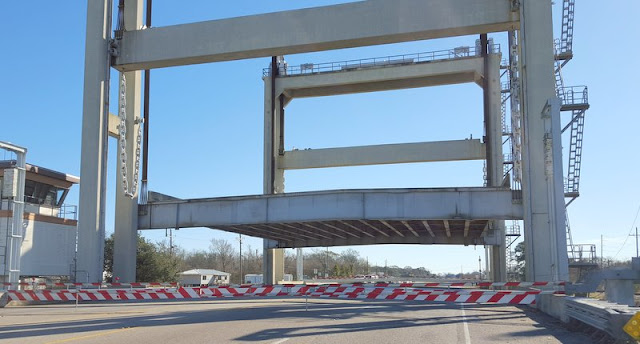Sugar cane seems to be in different growing stages throughout the region. Some fields were barely showing green, while other fields had 3-foot sugar cane already growing. We even saw some six-foot-tall cane being harvested.
But the most interesting were the rice fields. The crop is planted in the spring and harvested in the fall. That growing schedule means that during the winter, these flat fields can be flooded to grow crawfish instead. The red caps seen above the water are the tops of crawfish traps.
To see what lies below the red tops, Betty had a crawfish trap on her patio. One must just imagine crawfish in the trap rather than red Christmas lights.
We also had to ask what the curious mud mounds were that we first saw beside our motor home. Sometimes up to ten inches tall, most of them had a sizable hole in the middle.
Betty explained that there are crawfish everywhere underground in the area. These holes are evidence that our nearest neighbors were crawfish, coming up through the mud to meet us. It makes perfect sense to us now that one of their nicknames is "mud bugs."
We had another new experience as we approached this bridge and the red lights started flashing and the safety arms came down in front of us.
We had a front row seat to watch as the floor of the bridge raised ten feet to allow a tall boat to pass underneath. For a local, this would probably be an inconvenient nuisance. For a couple of travelers from land-locked Oklahoma, it was an enjoyable educational experience.
Our next stop was Avery Island, home of the Tabasco factory. For over one hundred years they made only one flavor of their famous pepper sauce. But today, Mark is standing among the six new flavors of Tabasco sauce--habanera, garlic, sweet and spicy, jalapeno, buffalo style, and smoked chipotle.
Tabasco has been made in Avery Island, Louisiana, since it was invented by Edmund McIlhenny in 1868. There is a new visitor's center and museum that opened just this month, and we learned the history and process of making this hot pepper sauce. It starts with grinding red peppers into a mash that is loaded into wooden barrels into this warehouse. They will ripen here for up to three years, and the smell was definitely "ripe."
The only ingredients in Tabasco are red peppers, salt, and vinegar, but their secret process of combining those three things has kept them busy filling 700,000 bottles every day. We went on a Monday (rather than a weekend) so we could watch this fast and furious bottling process. But we didn't understand that most of Louisiana shuts down the Monday and Tuesday of Mardi Gras week. We took no pictures of a dark and empty bottling plant today. But we did take a picture in their general store, full of all things made of peppers. That would include samples of two kinds of sweet and spicy ice cream--pepper sauce and jalapeno.
Our next stop for learning about Acadiana agriculture and industry was a tour of the Konriko rice mill in New Iberia. Now on the register of historical places, this rice mill was built in 1912 to mill the area's rice crop.
We found that they actually do very little milling now, as evidenced by the cob webs on most of the equipment. But it was interesting to find out the milling process. This model of the inside workings of the mill taught us about shelling the hull, then polishing the brown rice into white rice, and finally sorting the grains by size.
We met the owner of the Konriko company (and his puppy) while we were visiting. He was very friendly and we found that their main business now is packaging rice and seasoning packets under their company label.
We might be retired, but we enjoy seeing and learning new things in new places. This week we have been "enrolled" in Acadiana 101, learning as much as we can about life in Southern Louisiana. Traveling across the country in a motor home is a great way to do that!













No comments:
Post a Comment